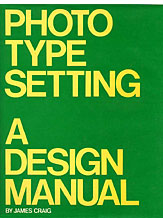|
Phototypesetting: A Design Manual was
published in 1978 to address the introduction of a new typesetting technology
that challenged a generation of designers familiar with only metal type
technologies.
Phototypesetting offers the designer a complete, graphically illustrated guide
to phototypesetting. To help the reader find the necessary information quickly,
the book is presented in a series of self-contained units that are grouped under
four major headings.
Terminology. The basic typographic terms are introduced in this section:
typeface, type style, font, letterspacing, wordspacing, linespacing,
x-height, etc. Also covered are points, picas, and the unit system.
Design. This section deals with making day-to-day design decisions that fully
utilize the unique potential of the phototypesetting process: choosing typefaces
and type sizes; mixing typefaces and type sizes; matching type; controlling
letterspacing, wordspacing, letterspacing, and linespacing; indicating paragraphs;
working with display initials, boxes, bullets, rules, borders, ligatures, small
caps, under scores, leaders, and fractions, to name only a few.
Copyfitting. Because character-counting methods vary from one phototypesetting
system to another, the reader is shown various ways of obtaining an accurate
count. Also covered in this section are copy preparation and markup,
using proofreader’s marks, copyfitting tabular matter, writing to
fit, and comping techniques.
Phototypesetting Systems. This section explains the basic components
of a phototypesetting machine and the various systems. By knowing what
each system can do and cannot do, the job can be matched to the equipment,
and the quality and cost controlled.
“ A thorough and exacting compendium which will prove invaluable
to anyone who needs to understand the basic vocabulary of modern photo
composition,”
Ivan Chermayeff
“An excellent book for students and experienced typographers.”
Peter Brattinga
224 pages. 8 1/2 X 11 inches. Over 650 B/W illustrations. An appendix
covering the the Metric System, and Didot System as well as an extensive
glossary, bibliography, and index.
ISBN 8230-4011-9
Watson-Guptill Publications
Return to top |
|

